
Steamboats in the Movies, page 5
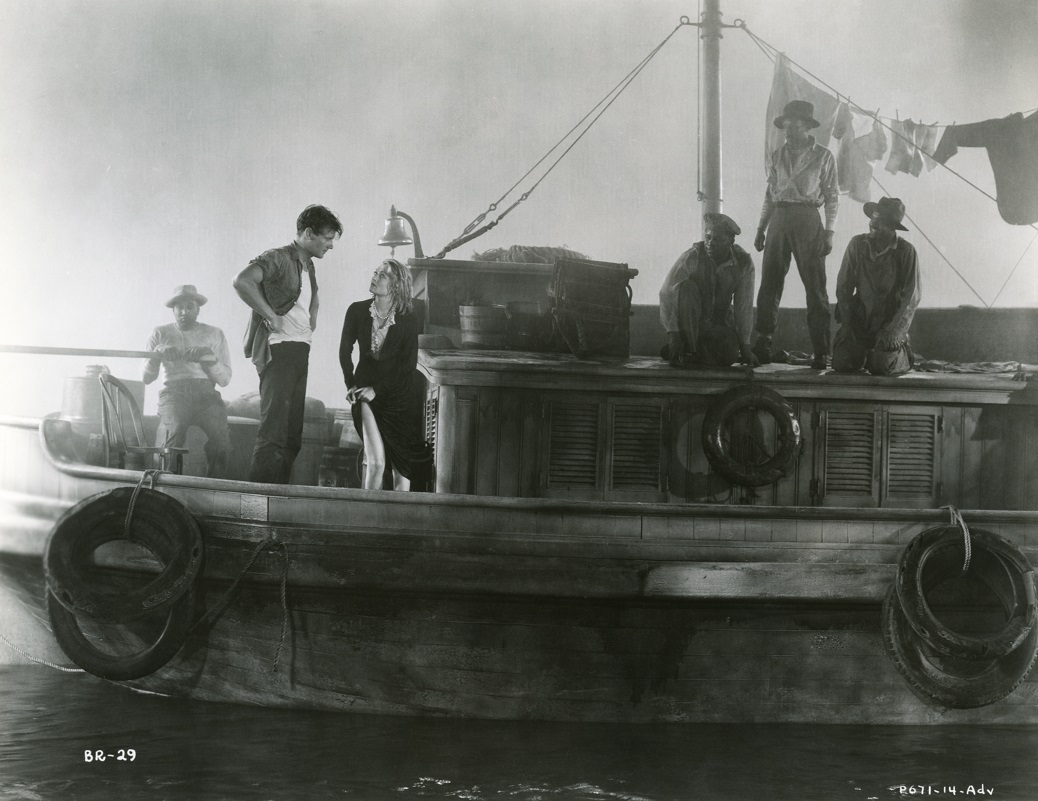
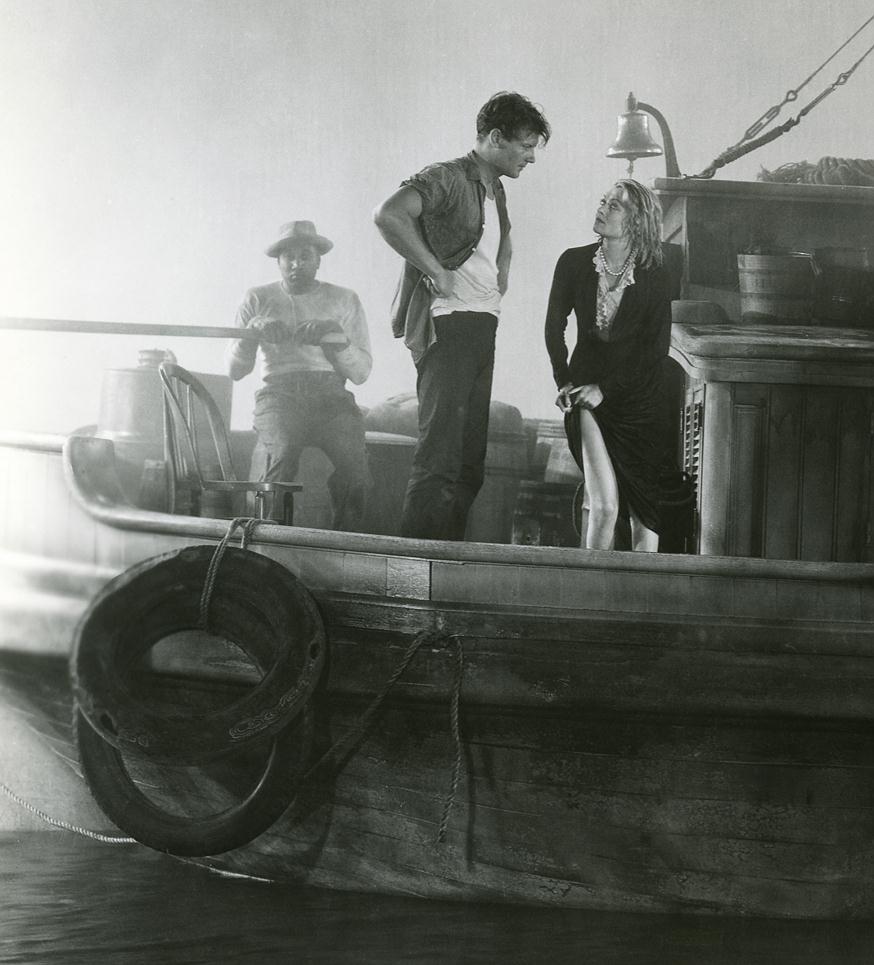
BED OF ROSES Constance Bennett Joel McCrea 1933
In the 1933 RKO movie BED OF ROSES Constance Bennett plays a lady swindler/gold digger named Lorry Evans who has just been released from a ladies reformatory (probably in Baton Rouge) with Minnie who has the same inclinations. Minnie is played by Pert Kelton who many movie fans will remember for her portrayal of the Irish mother of Shirley Jones as Marian the Librarian in THE MUSIC MAN. As Minnie, Pert is the polar opposite of wholesome "Mama."
When the two girls board a steamboat on the Mississippi with New Orleans is their objective but their limited funds won't carry them that far, so they're considering another river town as a destination. A male passenger accuses Lorry of stealing money from him and and rather than be arrested by the Captain she jumps overboard (the steamboat is represented in the movie by stock footage of the Streckfus steamer CAPITOL, obscured by fog added with post production special effects) and some brief footage of the pilot house and boiler deck which may have been taken aboard the CAPITOL or could have been of the AMERICA when it was filmed for the silent film THE FIGHTING COWARD in 1924. The stateroom that the Lorry and Minnie share and the boiler deck outside were full sized partial sets were built on a sound state to details of the steamboat.
Joel McCrea as "Captain Dan" and his African American crew are aboard Dan's cotton barge which is nearby in the fog as Lorry swims close by and she yells to anyone on board to help her up and out of the Mississippi. She gets into a dispute with Dan after he helps her aboard and she retaliates by pushing him into the river but he's pulled back aboard by two crewmen. Dan invites Lorry to his cabin where he gives her a man's shirt and bib overalls to replace her dress which was soaked while she was in the river. Lorry notices that Dan keeps his cash in a "poke" in an inside pocket of his coat which he hangs in the closet and after he lets her have his bed for the night he goes up on deck to sleep. Dan wakes up the next morning after arriving at New Orleans where he had overslept and is told that Lorry left without any breakfast and he discovers that she stole his money while she was alone in his cabin the night before and he vows to look for her in New Orleans.
The "cotton barge" set in this 8x10 is floating in a tank on a sound stage evidently and steered with a tiller at the stern of the boat but it's not clear whether the barge was supposedly run by steam or a gas engine. A synopsis from TCM and Mordaunt Hall's 1933 review in the NY Times provides commentary on the plot, characters and performers:
Bed of Roses (1933)
Wednesday, July 19 @ 04:00 PM (ET) - tcm.com
Synopsis
As soon as they are released from prison, crafty and tough Lorry Evans and Minnie Brown board a Mississippi River steamboat bound for New Orleans.
Short on cash, the women invite two boll weevil exterminators to their cabin and, after getting them drunk, steal their money.
When Lorry's activities are reported to the captain, she jumps overboard rather than be arrested, but loses the stolen cash as she is pulled from the water by Dan, the skipper of a passing cotton barge. Although she is attracted to the manly Dan, Lorry robs him of sixty dollars and, once docked in New Orleans, heads for the office of Stephen Paige, a wealthy publisher whom she had spotted on the steamboat. Using an array of feminine tricks, Lorry seduces the straight-laced Stephen and then blackmails him into making her his well-kept mistress. Once established with Stephen, Lorry returns to Dan's barge to repay him for his involuntary loan and ends up falling in love with him. Although she at first accepts Dan's marriage proposal, Lorry, who has kept her affair a secret, changes her mind when a lovesick Stephen convinces her that her past deceptions will one day lead to Dan's ruin. Lorry abandons Dan but, rather than stay with Stephen, moves to a rooming house and takes a job in a department store. With Minnie's help, Stephen locates Lorry and, during a Mardi Gras party, makes a final, unsuccessful bid for her return.
Minnie, seeing her friend's desperation, tracks down Dan and, after revealing her friend's past, reunites the two lovers.
MOVIE REVIEW
Constance Bennett Appears in "BED OF ROSES"
a New Film at the Radio City Music Hall
By MORDAUNT HALL
Published: June 30, 1933
New York Times
After having witnessed Constance Bennett as a smart young American with a gift for polished repartee in the film of "Our Betters," it is somewhat disconcerting to see her emerging from a reformatory in the picture, "Bed of Roses," which is now at the Radio City Music Hall.
The well-spoken girl of the Maugham story has been transformed into a callous creature named Lorry Evans, who is determined to have her "bed of roses," cost what it may.
The new offering is far from edifying and the characters do not always behave as if they were drawn from life.
It is a case of the plot having precedence over the conduct of the persons involved.
But there are scenes that offer a change from those usually to be found in this type of narrative. For instance, part of the action takes place on a Mississippi steamer bound for New Orleans and subsequently there are glimpses aboard a cotton barge.
Lorry is accompanied on the Mississippi craft by another audacious, slangy woman known as Minnie played remarkably well by Pert Kelton There are some reprehensible incidents on the steamer, which end with Lorry leaping overboard when she is accused of stealing money from one of the male passengers. She is guilty and she makes a bold bid for freedom by swimming up to Dan's cotton barge. Dan, played by Joel McCrea, helps her on board, but in the process she loses the money she had stolen.
Some idea of her fiery temper can be grained from her actions when she realizes the money is gone.
Dan leaves his roll of bills where it is easily found by Lorry and she robs him and vanishes from the cotton barge when it makes a stop at a wharf. Having observed Steve Paige, a wealthy publisher of New Orleans, on the Mississippi trip, Lorry tackles him when she reaches New Orleans, posing as a newspaper writer for a syndicate.
Mr. Paige, who is portrayed by John Halliday, falls an easy victim to Lorry and the result is that she finds herself living in luxury. Perhaps it is to her credit that she has returned the money she stole from Dan, who falls in love with her.
As one might surmise, Lorry soon discovers that she loves the skipper of the barge and she decides to become his wife, but Paige, having contributed a small fortune to supplying Lorry with a spacious home and costly gowns, tries to dissuade her from leaving him.
One of the New Orleans episodes depicts a carnival ball, which is staged most effectively. It is here that Paige hopes to find Lorry, who has left him to work in a department store, to see if she could put up with hardships after having found her "bed of roses." To say that Dan persists in wanting to marry her, no matter how reckless she has been, is not giving away any great secret, for it is apparent that these two will only be separated for the period necessary to such a tale.
Miss Bennett's acting makes her rôle much more interesting than it might have been in less talented hands.
Mr. McCrea is ingratiating if very credulous and susceptible as the barge captain.
Pert Kelton does remarkably well as the slangy Minnie and Mr. Halliday makes the most of the rôle of the spineless Mr. Paige.
BED OF ROSES
based on a story by Wanda Tuchock directed by Gregory La Cava an RKO Radio production
Lorry Evans . . . . . Constance Bennett
Dan . . . . . Joel McCrea
Steve Paige . . . . . John Halliday
Minnie . . . . . Pert Kelton
Father Doran . . . . . Samuel Hinds
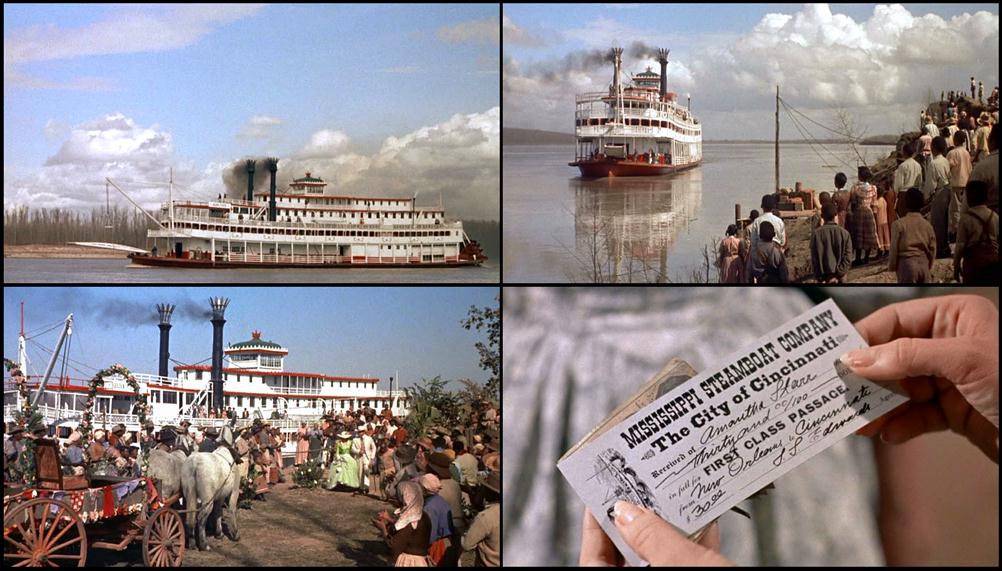
The DVD of BAND OF ANGELS is in a widescreen format so these frame captures came out pretty well.
The GORDON C. GREEN in the 1957 Warner Bros. Civil War era movie BAND OF ANGELS.
Filmed on the Mississippi River at Geismar, Louisiana.
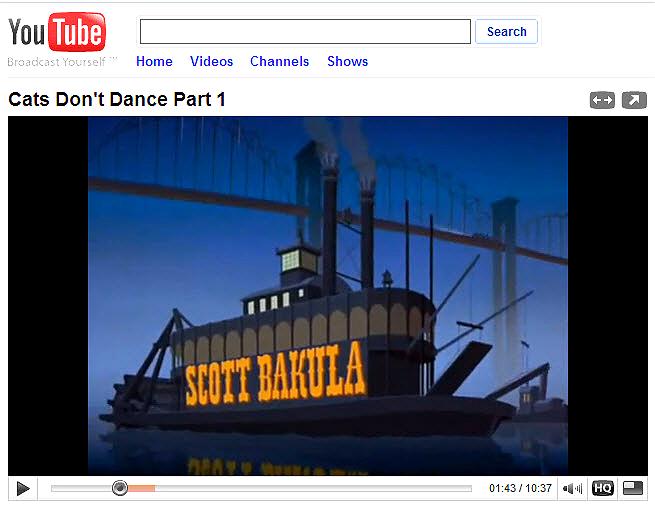
Francis Parkinson Keyes used research Fred Way provided on I believe it was the RICHMOND so she could describe a steamboat inside and out with accuracy in her novel Steamboat Gothic. I think Fred said he was invited to a party given my Ms. Keyes' at the old Beauregard house in the French Quarter which she owned and where she lived, to thank people who had helped her with the historic research etc. on the book.
Disney's PRINCESS and the FROG, new animated feature is set in New Orleans in the early 1900's (I guess) and uses some steamboats but from the scenes I've seen in the trailers and ads you can tell they didn't do much research on the boats . . . on of 'em didn't have a pilot house (lots of artists lop them off since they have no idea what they are for) or they leave off the 'scape pipes and generally make them look like modern excursion replicas which are so obviously inaccurate to people like us.
At least in CATS DON'T DANCE (an animated feature that I worked on) the art directors asked me for research and I loaned them blueprints and videos of the JULIA BELLE for reference and the result is reasonable. Attached screen capture of Scott Bakula's "credit" in the Main Title attached to the steamboat. This screen capture came from a video once posted at Youtube.
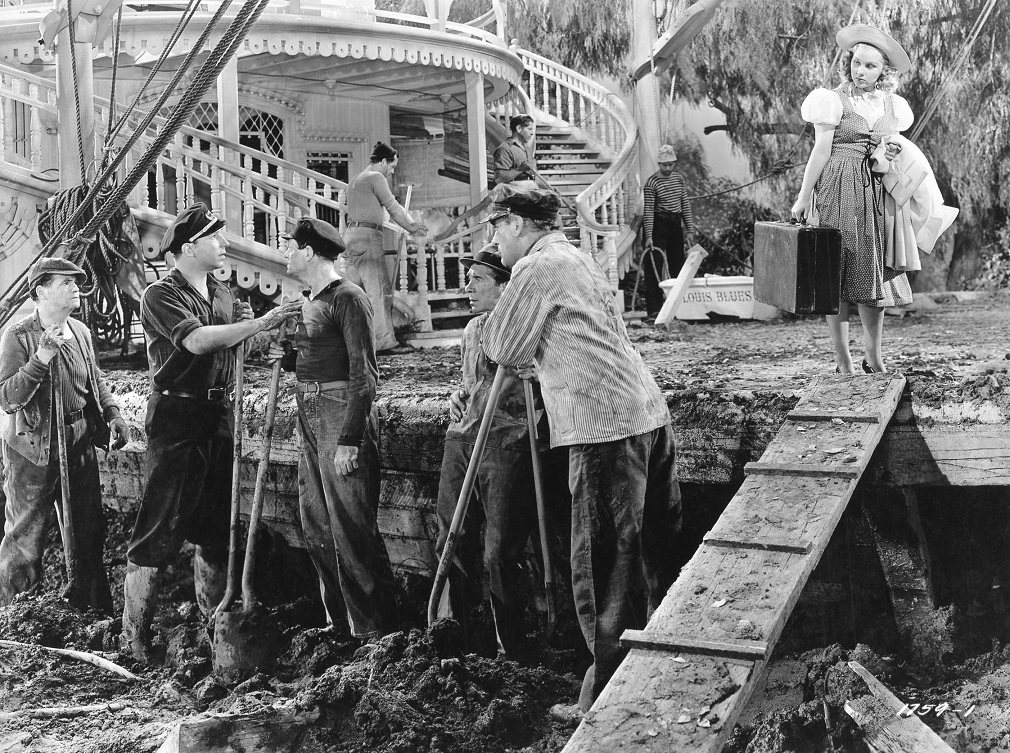
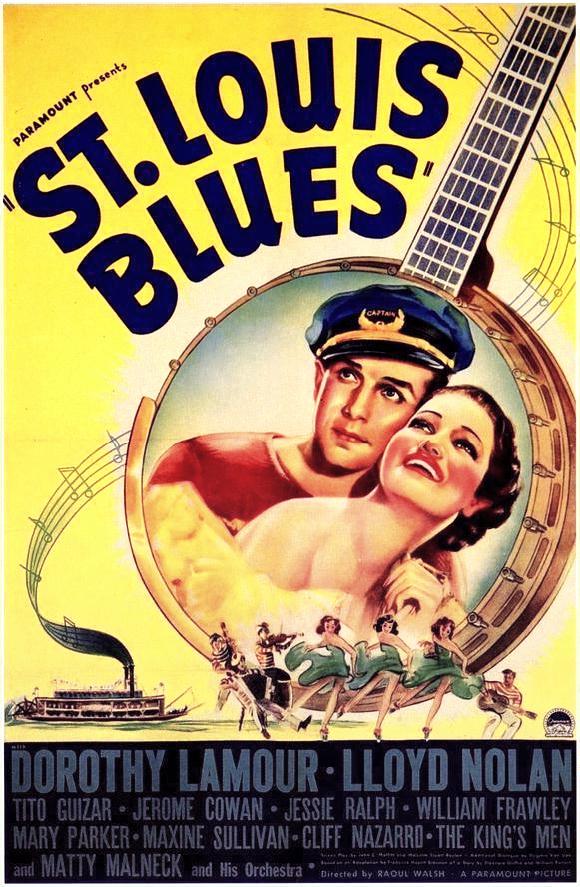
ST. LOUIS BLUES
Reviewed by FRANK S. NUGENT
New York Times
February 9, 1939
If you approach it in a tolerant night-clubby mood, and just don't try to make any sense out of it, "St. Louis Blues," at the Paramount, may strike you as a mess of fine, nit witty entertainment.
If you pay any attention at all to the story, on the other hand, it may leave you with a feeling that the picture is a libel both on a progressive Missouri metropolis and the Mississippi River. It isn't that the Father of Waters can't take it, as it has in the past from various dramatic and musical comedy sources, but sometimes these chambers of commerce get sensitive and every now and again they even sue.
Never has a Mississippi flood been put to more frivolous uses than the one which carries Dorothy Lamour—a fugitive from a sarong-from a Pullman in her stalled train to the show-boat of old Captain Lloyd Nolan and into a new theatrical career along the levees.
It seems that Miss Lamour wants to get away from Jerome Cowan, her manager, who has got her typed, for some reason, as the kind of an actress who can't put over a song without a sarong.
Cap'n Nolan's show-boat is full of characters whose quaintness would fill even Maxwell House with misgivings: Jessie Ralph as Aunt Tibbie, whom you'll just have to see for yourself; Tito Guizar, as the loviest-doviest doggone Latin you ever saw; Mary Parker, as Punkins, in pursuit of whom Tito stows away in a broom closet; Maxine Sullivan, who sings exactly like a colored swing singer, specializing in "Ochi Chornya" and "Loch Lomond," by the name of Maxine Sullivan, and—but we warned you not to try and make sense out of anything.
ST. LOUIS BLUES, as adapted by Frederick Hazlitt Brennan from a story by Eleanore Griffin and William Rankin; screen play by John C. Moffitt and Malcolm Stuart Boylan; directed by Raoul Walsh; produced by Jeff Lazarus for Paramount.
Dave Guerney . . . . . Lloyd Nolan
Norma Malone . . . . . Dorothy Lamour
Aunt Tibbie . . . . . Jessie Ralph
Ivar De Brett . . . . . Jerome Cowan
San Ramos . . . . . Tito Guizar
Ida . . . . . Maxine Sullivan
Major Martingale . . . . . William Frawley
Punkins . . . . . Mary Parker
The Band . . . . . Matty Malneck and His Boys
Sheriff . . . . . Victor Kilian
Mr. Hovey . . . . . Walter Soderling
Shorty . . . . . Cliff Nazarro
Mrs. Hovey . . . . . Virginia Howell
The King's Men . . . . . Grafton Lynn

Panorama of 5 steamboats (three of them were scale models, the two on the far right in the foreground were a full size set) created by Paramount studio's special effects department under the supervision of Dewey Wrigley to represent the St. Louis waterfront in 1865 for a Cecil B. DeMille.
The epic Western entitled THE PLAINSMAN (1936) based on the real-life adventures of Wild Bill Hickock (played by Gary Cooper) and Calamity Jane (played by Jean Arthur) and Buffalo Bill Cody (played by James Ellison).
The scene opened on the far left with the second scale model boat traveling west while the camera pans to the right to where the full sized set and actors appear on the far right, all in the span of a few minutes.
This was an ingenious work of Hollywood magic and I only wish we had some "behind the scenes" photos that demonstrate how this wonderful and ambitious illusion was achieved.
This panorama was cobbled together out of four screen captures from the DVD. Amazon.com
The only boat whose name is visible is the ASSINIBOINE, named for a Native American plains tribe. The boat's pilot house looks like it had been stomped on and would scarcely have room for an adult pilot to stand up in. Other than that the boats all look pretty reasonable to the historic period.
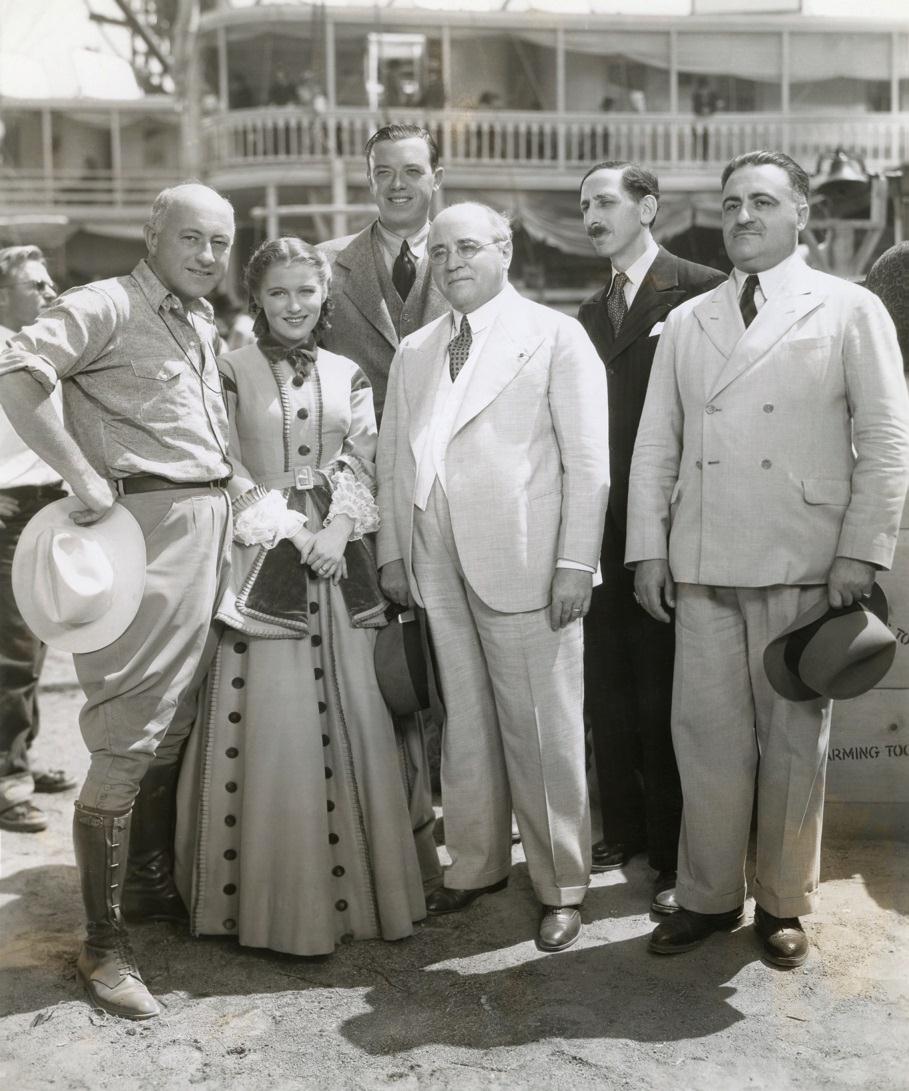
Here in 1936, Producer/Director Cecil B. De Mille and Helen Burgess (in costume in the role of Louisa Cody wife of "Buffalo Bill" ) host four visitors to an outdoor set built for THE PLAINSMAN on Paramount's back lot of 2 steamboats from the "hurricane deck" to the main deck and the upper portions of the boats (as they were supposed to look on the wharf at St. Louis) were provided by a "hanging miniature" in the foreground filmed through a deep focus lens which would keep both foreground the model and full sized sets in sharp focus for the camera as seen in our panorama of screen captures for a camera move that started on the left and panned right.
De Mille's other visitors were French-American film director Robert Florey (the third person, very tall), the man in the white suit was former French premier Albert Sarraut accompanied by the other two gents who were Roger Levy and Andre Touzet.
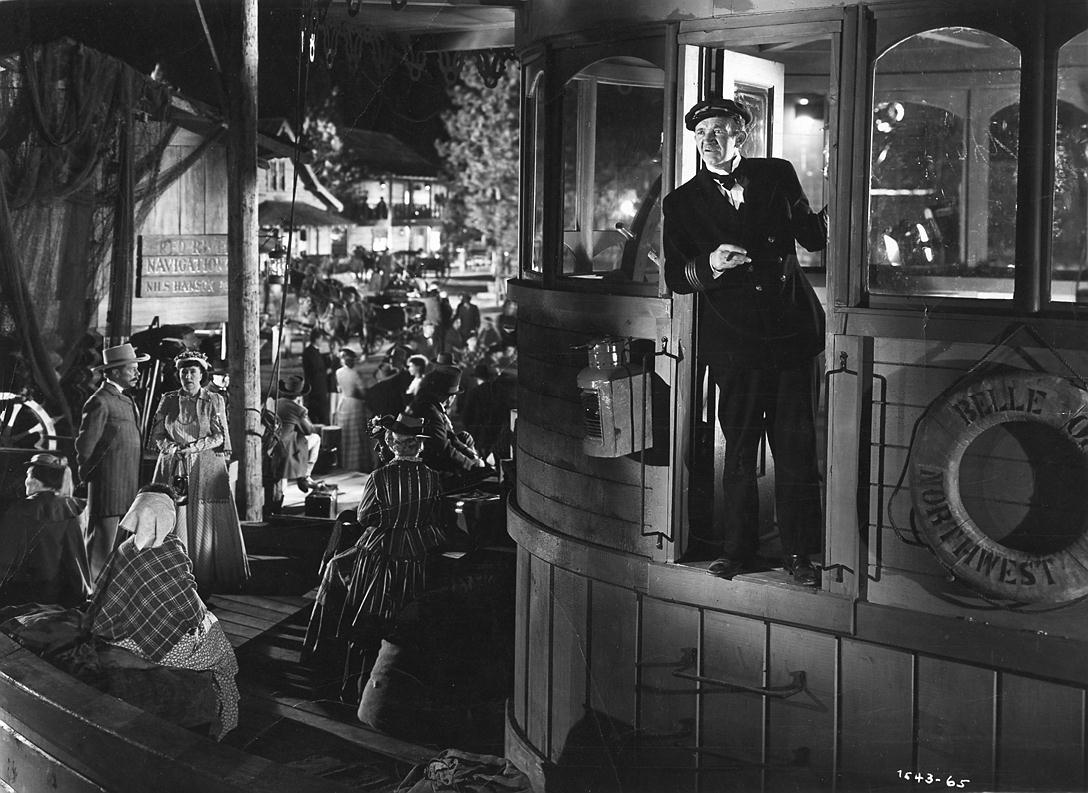
Walter Brennan as Captain Bounce in the pilot house of BELLE OF THE NORTHWEST in the 1935 Western DAKOTA starring John Wayne. Set in 1871, Bounce's boat navigates the Red River of the North and here it is tied up at Fargo, North Dakota. At one point in the film the BELLE gets stuck on a sandbar, a common occurrence on the frequently shallow and silted rivers Out West.
In the pilot house windows behind Brennan you can see the brightly shining lighting equipment used to illuminate the set reflected in the glass.
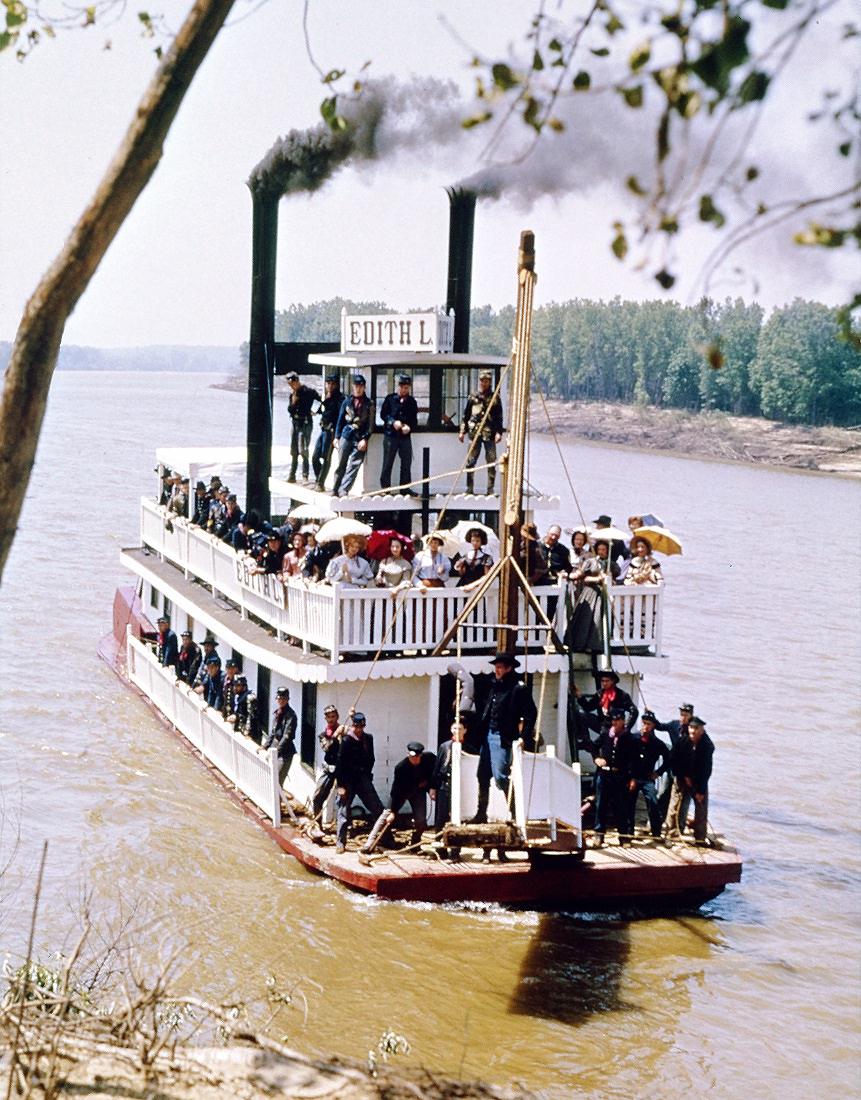
Steamboat EDITH L. was filmed along the Ohio River near Paducah, Kentucky
This is a detail scanned from an original 4 x 5 color transparency of a scene from the Civil War sequence in the 1962 MGM Cinerama Western Epic HOW THE WEST WAS WON directed by STEAMBOAT ROUND THE BEND director John Ford. George Peppard as Union cavalryman Lieutenant Zeb Rawlings stands on the swinging stage, ready to disembark from the EDITH L. after the war is over in order to return to his family's farm along the Ohio River in Southern Illinois.
The steamboat EDITH L. was filmed along the Ohio River near Paducah, Kentucky. It appears to have been previously a small towboat or a replica riverboat built for leisure or cruises. The boat must have had a paddlewheel at the stern although the wheel was apparently not propelled by pitman arms but instead by a later-day chain drive judging from the housing which can be glimpsed at the rear of the boat. Many of the extras on board are attired as soldiers in Union uniforms returning home or changing their duties from s wartime to a peacetime military likely to be devoted to fighting Native Americans on the Western frontier. A couple of crew members wearing nautical / naval style caps are busy on the main deck. There are ten ladies standing forward on the boiler deck wearing 1860's fashions and shading their heads and shoulders with parasols.
The man standing on the far right in front of the pilot house looks almost as if he was wearing an aviator's outfit, including an aviator cap with goggles visible on the front of the cap. Swinging stages would be developed after the war and railings, with or without "fencing" for passengers and crew members to hold onto as they got on and off the boats would come along later.
If anyone recognizes the EDITH L. or knows some of her history, steamboats.com would be glad to hear from you so we can expand this caption.
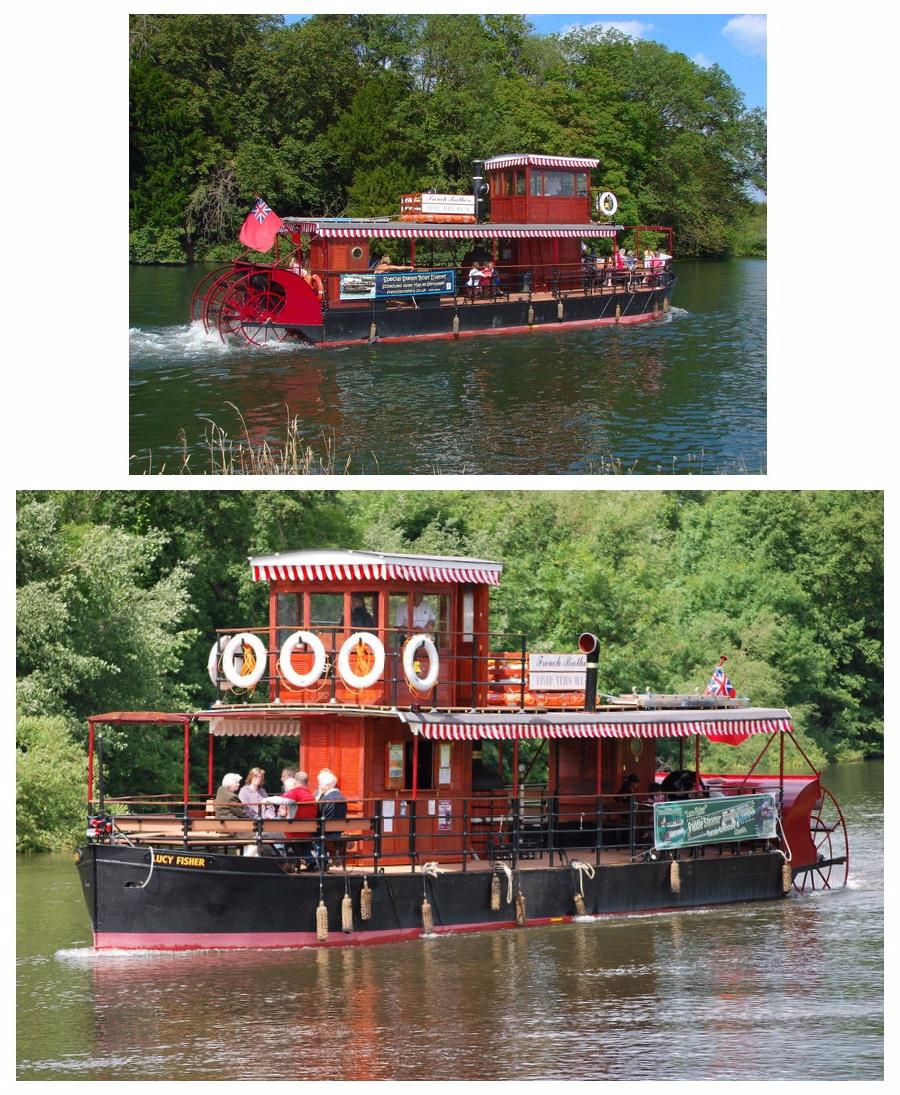
Paddle steamer LUCY FISHER in England
Photo credits
TOP: geograph.org.uk
BOTTOM: skyscrapercity.com
video: Paddle Boat Lucy Fisher At Runnymede, Windsor England Youtube
Bob Explores
LondonPublished on Jun 9, 2012
Originally built for "Tarzan - the Legend of Greystoke", (1984) the LUCY FISHER is a replica of an African Paddle steamer now plying the River Thames at Runnynede famous for being where the Magna Carta was signed. The FISHER appeared again in the biographical movie CHAPLIN (1992) filmed along the shoreline of the former Astor estate in the vicinity of Cliveden House in Berkshire.
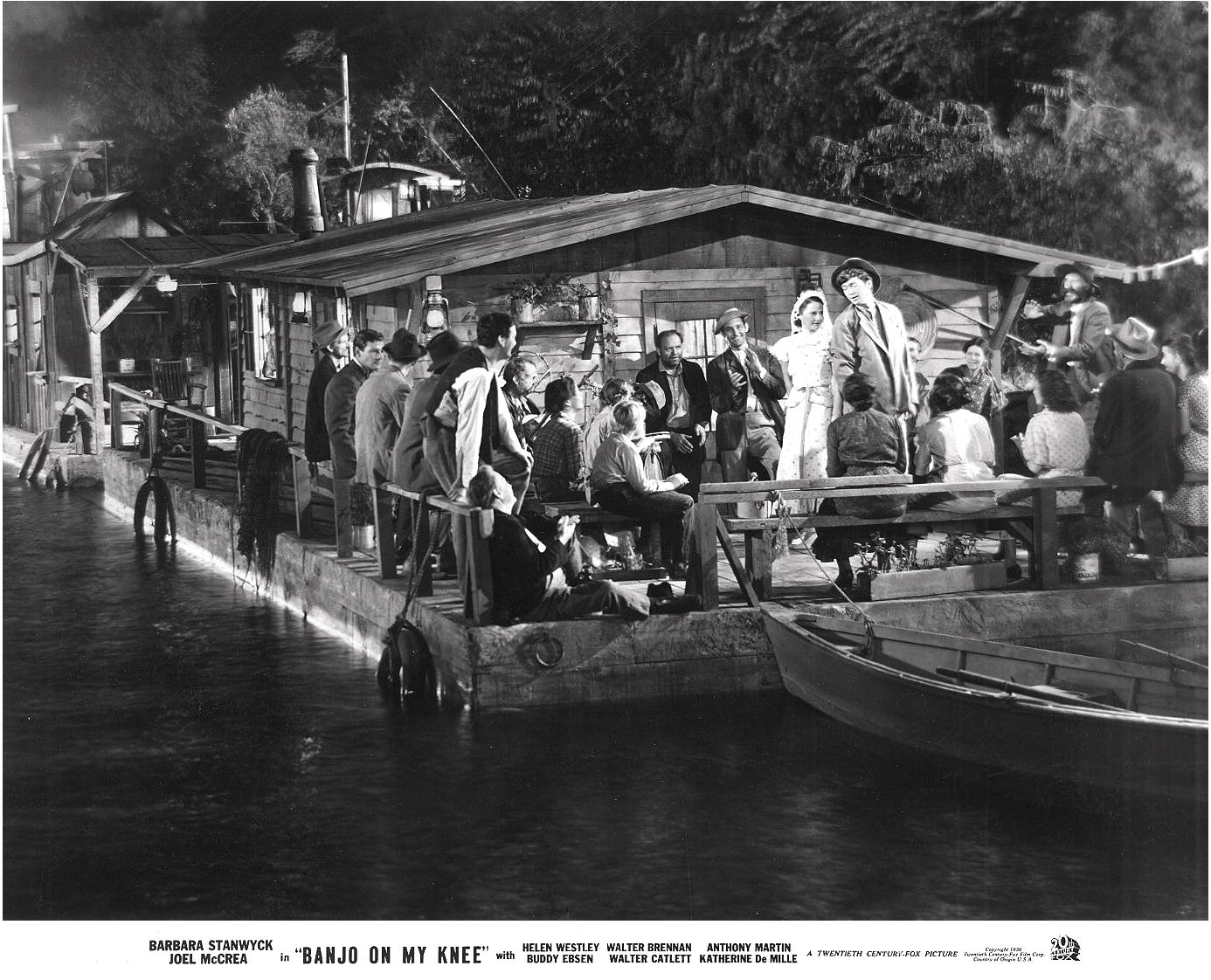
Banjo on My Knee (1936)
20th Century Fox
95 min - Comedy | Drama | Romance
Ernie Holley runs away on his wedding night because he thinks he has killed a man on his wedding night.
His father Newt and bride Pearl travel to New Orleans to find him and persuade him to come home. However, they end up starting a successful Vaudville act instead.
Banjo on My Knee,' a Shantyboat Musical, Opens at the Roxy
By FRANK S. NUGENT
TIME MAGAZINE
December 12, 1936
If we are to believe the Roxy's "Banjo on My Knee"—and there isn't an earthly reason why we should—the picturesque shanty-boaters of the Mississippi are nothing more than song-and-dance men in the rough, homegrown crooners, players of one-man bands or torch-singers of limited range and a tendency to grow moist-eyed whenever they hear that old American folksong, "The St. Louis Blues." It is an unsettling premise, disillusioning and unthinkable, and it impels us to scowl fiercely at the ballyhoo artists who have been telling us that the new Twentieth Century-Fox picture "combines the setting of 'Tobacco Road' with the mood of 'Steamboat 'Round the Bend.'" It ain't no such thing.
There are, we suppose, a few traces of the Harry Hamilton folk novel in Nunnally Johnson's script. Old Newt Holley, under Walter Brennan's disarming portrayal, comes closest to realizing our conception of the shantyboater. "Looks like Judge Tops is fixing to fall into the river," he says, with a careless eye upon the nodding figure of the judge, precariously slumbering underneath the taffrail. His guests turn casually and wait for the sleeper to sway too far. "Wa'al, guess you'd better fish him out, Buddy," says Newt, a placid interval after the splash. Old Newt does much to restore our faith in our fellow men along the Mississippi's banks.
But "Banjo on My Knee" leans far more on the side of musical comedy, with biological implications, than it does to an honest tale of the stepsons of Old Man River. Its theme, bluntly, is Newt's desire for a grandchild—a hunger thwarted, beyond audience endurance, by the coincidences, quarrels and misunderstandings which separate his son, Ernie, and his wife, Pearl on their wedding night and keep them apart until a barroom brawl, a rising river and a boarded door force them to bow to Newt's ambition. This being an issue of less than major importance, we found ourselves singularly unmoved by Barbara Stanwyck's tragic demeanor as Pearl and thoroughly irritated by the stupidity of Joel McCrea's Ernie.
Only Mr. Brennan's Newt, the sporadic hoofing of Buddy Ebsen, the Hall Johnson choir's collaboration with an anonymous soloist on "The St. Louis Blues," Anthony Martin's singing of "There's Some-thin' in the Air" and a sound comedy performance by Walter Catlett as an abused photographer emerge as definite entertainment factors. Fortunately, they are in attendance constantly enough to keep us from brooding too much upon the inadequacy of the story.
BANJO ON MY KNEE, based on the novel by Harry Hamilton; screen play by Nunnally Johnson; music and lyrics by Jimmy McHugh and Harold Adamson; directed by John Cromwell; a Twentieth Century-Fox production. At the Roxy.
Pearl . . . . . Barbara Stanwyck
Ernie Holley . . . . . Joel McCrea
Grandma . . . . . Helen Westley
Buddy . . . . . Buddy Ebsen
Newt Holicy . . . . . Walter Brennan
Warfield Scott . . . . . Walter Catiett
Chick Bean . . . . . Anthony Martin
Leota Long . . . . . Katherine de Mille
Slade . . . . . Victor Kilian
Ruby . . . . . Minna Gombell
Judge Tops . . . . . Spencer Charters
Jules . . . . . George Humbert
Gurtha . . . . . Hilda Vaughn
Hattie . . . . . Cecil Weston
Eph . . . . . Louis Mason
And the Hall Johnson Choir.
This movie is available instantly at Netflix.

All captions provided by Dave Thomson, Steamboats.com primary contributor and historian.
